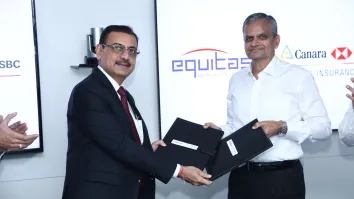Sinking? You can still save your bank!
By Nick Quin Did you hear the one about the man who jumped from a burning oil rig?
Come to think of it, you probably have. The story of the "burning platform" is well-worn in business circles thanks to what the hero is alleged to have said to rescuers after they plucked him from the frozen North Sea: "Better probable death than certain death". Presenters love the metaphor because it dramatically illustrates how, in business, standing still is often the riskiest option of all. That is a lesson that cannot be over-learned.
However, most challenges we face in business -- even those with great destructive potential -- come in far less explosive forms. In fact, most companies are better equipped at managing a fast-moving crisis than they are at responding to the subtle shifts and undercurrents that pose the greater long-time threat. Risks emerge slowly, damage accrues over time, and certain death for most businesses comes after a thousand cuts.
It may seem self-evident, but the first and most critical step if you find yourself on a burning platform is to acknowledge it is on fire. This is where a surprising number of companies fall down. And the dangers of missing the signs are real and manifold. An outdated, inefficient back office investment management system invariably leads to unpredictable and often steeply rising costs, while exposing the company to significant operational risk. Such systems also tend to inhibit growth because they lack scaleability and the ability to support evolving markets or accommodate unforeseen contingencies.
Most investment managers I deal with tell me a version of the same story: they came to understand the dilapidated state of their IT infrastructure and processes only after it had reached a crisis point. Until then, they had made do -- showing McGyver-like ingenuity - with a combination of dated legacy software, customised spreadsheets and bespoke add-ons.
This is a revealing insight because over-reliance on ad hoc solutions is itself a prime indicator that your technology platform has already caught fire. Here are six others:
1. Is your vendor's client base declining?
2. Is software maintenance and vendor support declining in quality and frequency?
3. Do you have slow time to market caused by the need to work around your software limitations and/or develop new spreadsheets?
4. Has your vendor shifted focus to different markets or products, or is there disruptive uncertainty around future ownership arrangements?
5. Did the vendor spend less than 15 percent of annual revenue on research and development?
6. Are you still running your core investment management software on a 32-bit platform rather than being 64-bit enabled?
If you find yourself saying yes to these questions, chances are your platform is already sinking beneath your feet. And, since the process of modernisation -- from inception to completion -- is a 24-36 month journey for most businesses, this might be the moment to make the first step.
Many in the retail banking sector have done the sums and concluded now is indeed the time. The case for modernisation was given fresh urgency after for example the DBS systems outage left customers frustrated and the banks themselves scrabbling to rectify the situation. It is therefore welcome news that five major banks in the Asia Pacific will increase their technology and systems investment by 49 percent over the next five year. They recognise – not a moment too soon -- that archaic legacy platforms are slowing them down and stifling growth.
Investment managers can benefit from a similar self-assessment. Is our current system equipped to cope with future regulatory changes and market shifts? Or does it force us to make do with suboptimal, often manual, solutions? Is it geared to the future or stuck in the past?
It's a tough call in the current climate to justify any kind of long-time investment of time and resources without the promise of quick revenue. In investment management, as elsewhere, growth is synonymous with survival. But if the 'burning platform' story taught us anything, it's that standing frozen in time is no way to grow – or survive.



















 Advertise
Advertise










